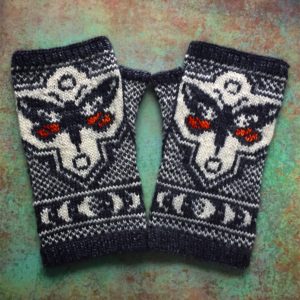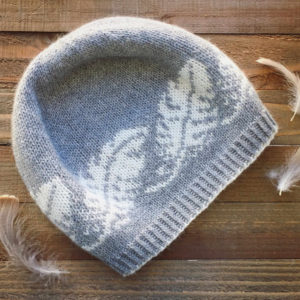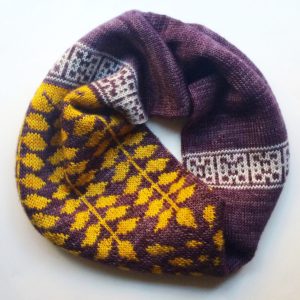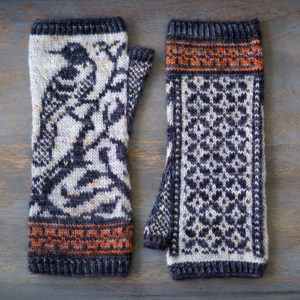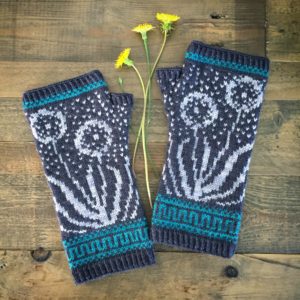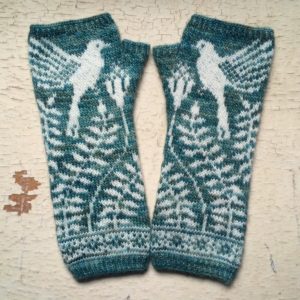I got to interview Erica Heusser, ericamay on Ravelry, @eheusserdesigns on instagram.
My process for developing motifs goes like this: Pick a reference, chart the reference, knit the swatch, compare the swatch to the reference, alter the chart, repeat from 12 to 18 times. Whenever I whine, my husband asks which iteration I’m on. If it’s less than 12, he says, oh, you have a few more iterations to go that’s all. Since your process involves drawing the reference, what is your process like?
Wow, I’m impressed by your patience and persistence! Often I’ll do a thumbnail sketch of my idea before I begin charting, and then proceed to constructing the chart – “drawing” the original image into a template I’ve created on the computer. I think this is the most time-consuming part of my design process. Once I feel satisfied with the chart, I start knitting it up. Sometimes if I’m very lucky, the first knitted item becomes my sample, and other times, it’ll take two or three iterations before I’m happy with the design.
Do you make choices about the poses of your animals to make it easier to knit the object or grade the pattern?
Absolutely! It’s always a compromise between the design I envision in my head and a design that is suited to stranded knitting. My design aesthetic in fine art is maybe a bit more simple and spare than I am able to execute in my knitting patterns!
How do you think your art therapy experience plays into the cycle?
This is such an interesting question. I have been making art my whole life (my parents were art teachers) and I feel that both art therapy and pattern designing have grown out of a sort of lifelong creative evolution. I don’t know that my art therapy experience directly influences the designs I create, but I think it allows me to be more accepting of my process. I tend to be hard on myself, and my work in the field is teaching me to be more patient when it comes to my own creative process.
Do you including fiber arts in your practice with clients?
At this time, I do not, although I think there is so much therapeutic value in the process of knitting and mastering new skills.
How do you choose your subjects and name them?
I am mostly inspired by nature. I have gotten into birding and wildlife photography over the past year; I’ve immersed myself in nature – at parks, wildlife refuges, beaches, woods, meadows, and wetlands… I think those experiences are helping me return to designing with renewed energy and enthusiasm for the subjects that I’m working with.
I often have a hard time naming my patterns; some of the names are pretty literal, and some are more conceptual… it’s not easy for me to choose a name that captures the essence of a design! The pattern name is usually the very last piece to fall into place when I’m creating a pattern.
Any tips on getting better at drawing?
Practice! Trust in your own capacity to grow and improve. I think it can also be helpful to study the work of artists/creators that you admire. Oh, and my favorite tip: when you’re working on a drawing, look at it in a mirror periodically – I find that it’s a helpful way to spot any imbalances or composition issues.
Reference books are annoying for birds, because they are all posed in the same way!
When you simplify your drawings down to be charted, how do you choose what to omit?
I usually create a general outline, and place the most essential features – the eye, beak, tail, wing bars… this allows me to plot out accurate proportions, and then slowly begin to refine the features. I make lots of changes as I’m working.
Or is simplification different than I’m thinking?
Because I usually only start with a thumbnail sketch, there isn’t too much simplification required. When I’m charting the design, I’m working to create the most accurate representation of the image I see in my head.
Or is this something people learn in art school by drawing forever and getting feedback.
That helps too! 🙂
Any art tips on receiving feedback graciously?
Good question! I think it’s easy to get defensive when you perceive that someone is being critical – particularly when it comes to art and design. It’s helpful for me to remember that everyone is seeing and experiencing through a different lens. There’s no right or wrong in art, and there is plenty of room for differing opinions.
Photography is one area I struggle with as a designer. Did your art training help you take good photos?
Photography has been an interest of mine for a while as well… I think my art training informs my work, whether it’s pattern design, drawing, or photography. I do struggle a bit with finding creative ways of displaying knitted items. I’d love to include more modeled shots, but most of the time it is just me, the knitting, and the camera – and those shots are a bit tough to orchestrate!

